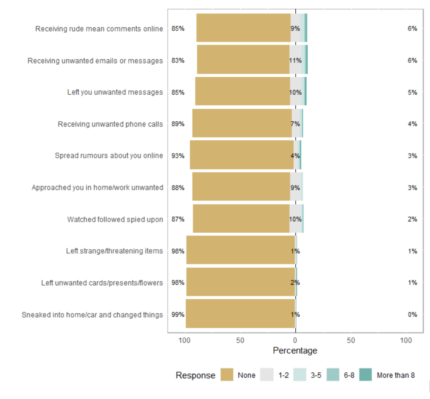Surveys of gender-based violence in higher education have primarily focused on sexual violence and harassment, while other forms remain under-explored.
However, there is evidence to suggest that students may be at heightened risk of behaviours such as stalking and domestic abuse. Despite guidance published by Universities UK outlining the work to be done in this area, there is a wider lack of attention to domestic abuse in prevention and response work within HE
When we were looking to survey students on stalking and domestic abuse – we found no UK-based surveys explicitly designed for student populations in these areas.
The closest tool we could find was the Administrator Researcher Campus Climate Collaborative (ARC3) survey tool – an open-access tool developed by American academic researchers and HE administrators and used extensively in campus climate surveys in the US. It comprises 19 modules covering victimisation and perpetration, as well as further modules on consent, alcohol use, and peer norms.
We used four victimisation modules from ARC3; sexual violence, sexual harassment, stalking, and ‘dating violence’ (defined in the survey as physical and psychological violence from an intimate partner). The first two modules proved appropriate and helpful for the UK context, as previously discussed on Wonkhe. But there were still challenges in using the modules on stalking and ‘dating violence’.
Now, in an ideal world, we would have had the time and resources to redevelop or adapt the survey to fit the UK context (or at least to wait for ongoing work at the Office for National Statistics on surveying domestic abuse to be completed). But we had to balance the perfect study design with the time limitations of working in vital partnership with student leaders (we needed to get the survey through ethical approval, out to students, and reported on within the one academic year they were in office). So, we ran the ARC3 survey without adapting it, reflecting that in the absence of any existing data on the specific population it would still provide valuable insights. The survey was sent to all students enrolled at the university in November-December 2020, and 725 of those who filled out the survey agreed to their findings being reported publicly.
Dating violence among students
We found that 26 per cent of respondents in our survey had been subjected to dating violence behaviours since enrolling at university. Physical experiences of dating violence included:
- 11 per cent (n = 78) of respondents reported experiencing at least one experience of being pushed, grabbed or shook by someone they’d been in a relationship with during their time at the university
- 4 per cent (n = 29) reported one or more experiences of being hit
- 1 per cent (n = 7) reported being physically beaten up once or more times
Relationships can also be abusive without any physical violence ever occurring. The survey asked about this aspect of dating violence by asking respondents “Not including joking around, the person threatened to hurt me, and I thought I might get really hurt”. 16 per cent (n = 114) of respondents reported at least one experience of someone scaring them without making physical contact. 8 per cent (n = 57) experienced being threatened.
While domestic abuse may be a single incident or several incidents, it is important to note that some students were being subjected to these behaviours “sometimes”, “often”, or “many times”. This included 2 per cent (n = 15) of those who received threats of harm and 1 per cent (n = 7) of those who were hit.

Figure 1. Frequencies of different types of dating violence experienced.
The person carrying out the behaviour was identified as “another student at the university” in 65 per cent of dating violence incidents, and they were described as male for 79 per cent of dating violence incidents.
These findings show a higher prevalence of dating violence than national data on domestic abuse from the Crime Survey for England and Wales (CSEW). In the CSEW, drawing on Roxane Khan’s analysis, full-time students are the most likely to experience domestic abuse compared to any other occupation at 7.7 per cent of the population, with women students (11 per cent) more than twice as likely than male students (5 per cent) to be victimised. The different sample populations can explain these differences; the CSEW includes all students 16 and over, not just those at university, but omits those within residential university accommodation.
What’s more, is that despite being higher than the CSEW, the findings in this study are still likely to be underestimated as they do not capture the full range of types of domestic abuse. Domestic abuse is defined in England and Wales as “any incident or pattern of incidents of controlling, coercive, threatening behaviour, violence or abuse between those aged 16 or over who are, or have been, intimate partners or family members regardless of gender or sexuality”. The ARC3 questions on dating violence focus only on physical and psychological violence and omit financial or sexual abuse where it occurs within the context of an abusive relationship.
A further limitation of the module on dating violence is that it does not capture coercive control as it was devised before it was recognised as a significant aspect of domestic abuse. In the UK, coercive control is now criminalised, and work is underway to devise appropriate survey questions to capture it. By contrast, the dating violence module used here focuses on physical violence. Andy Myhill demonstrates that studies that foreground physical violence are likely to obscure other gendered patterns of domestic abuse. While this study found a gendered pattern with women reporting twice as many incidents of dating violence than men, this may still be under-representing the gendered patterns.
These limitations mean these findings almost certainly underestimate the number of students subjected to domestic abuse. To make them somewhat more accurate, it would be possible to extrapolate the findings from the sexual violence module of the survey we previously outlined to include respondents’ experiences of sexual violence from an intimate partner. However, the modular nature of the survey makes it challenging to combine findings across different sections to build up a complete picture of domestic abuse.
Stalking behaviours reported by students
Overall, 16 per cent reported having been subjected to behaviours that fell under the measure of stalking used in this survey. We measured stalking by including anyone who had experienced one stalking event happening 6-8 times, three stalking events happening 1-2 times, or one stalking event at 1-2 times and one stalking event happening 3-5 times.
As shown in Figure 2, the three most common forms of stalking victimisation experienced by students were receiving rude/mean online comments (15 per cent), receiving unwanted messages via email, instant messenger or on social media (17 per cent) and leaving unwanted notes, texts or voice messages (15 per cent), all of which occurred at least one or more times. Some forms of stalking victimisation experienced were very intrusive. Twelve per cent report at least one experience or more of being watched, followed, or spied upon from a distance or with a listening device/camera or GPS. Twelve per cent also reported at least one experience of being approached at home, work, or school when they did not wish the person to be there.

Figure 2. Frequency of the different types of stalking experienced by students.
The person carrying out the behaviour was identified as “another student at the university”’ in 70 per cent of all reported behaviours and described as male for 89 per cent of those reported behaviours on the stalking module.
Research from the Suzy Lamplugh Trust notes that stalking “can lead to feelings of depression, anxiety and even post-traumatic stress”. Not only that, but it is also “a key indicator for future potential serious harm”. Stalking behaviours, therefore, need to be taken very seriously when they occur.
However, there were significant methodological issues with the survey tool. It was formulated in the US to ask about behaviours defined within the definition of stalking following the US legal framework, which aims to avoid vagueness and thus tends to specify behaviours. By contrast, stalking is defined in the UK as involving behaviours that engender fear or distress in a pattern of behaviour over time – focusing on the experiences of those victimised rather than the behaviours themselves.
The ARC3 questions did not capture this aspect of stalking, so these findings should be considered indicative rather than definitive in the UK context.
There were also other difficulties with this module. First, it was not possible to ascertain whether multiple events were carried out by the same person or group of people, therefore constituting a course of conduct. Second, the survey did not capture whether several events occurred within a specific time period. This is important because stalking events that continue for more than two weeks are “associated with a more intrusive, threatening and psychologically damaging course of harassment”. Hence, the period of time, as well as the number of events, is relevant. Finally, these questions must also be updated to reflect students’ increasingly digitally mediated lives.
Next steps
These differences mean that the ARC3 modules on stalking and dating violence would need to be significantly adapted to be suitable for use in the UK context. However, researchers and HEI leaders should not avoid gathering data on domestic abuse and stalking due to the absence of appropriate survey tools. Rather than using these bespoke surveys from the US context, using existing UK-based survey tools would make more sense. For example, survey questions from the Crime Survey England and Wales could be used to assess stalking behaviours in HE. For measuring domestic abuse, once ongoing work has been completed on CSEW questions on coercive control, they should be adapted to a short-form version for use in HE.
Institutions attempting to understand their populations to inform prevention and response efforts can use these measures to capture a wider range of behaviours. This should also be supplemented with data collection on attitudes such as ‘domestic abuse myth acceptance’. This data can be used to address the fact that the majority of perpetrators named were male students at the same university. Overall, these clear – if sobering – patterns of perpetration and victimisation clearly point towards the next steps to address the identified issues.
The full article on which this piece is based can be read here: Bull, A., & Bradley, A. (2023). Surveying ‘Dating Violence’ and Stalking Victimisation among Students at an English University: Findings and Methodological Reflections on Using a US Survey Instrument. Social Sciences, 12(10).
Thanks to Emma Short, who advised on the stalking findings and literature.














Having dealt with victims of ‘dating’ and intimate partner violence I would caution readers not to assume anything about both victims or perpetrators. By far the most violent and coercive incidents were in my experience between same sex individuals, with female/female violence being the most frequent.
Thank you, @anna_bull_ Ongoing critical analysis of our research methods is vitally important to the understanding and elimination of gender-based violence in higher ed.